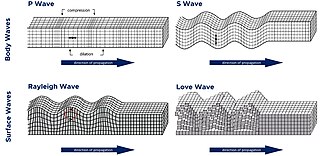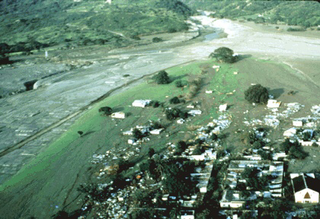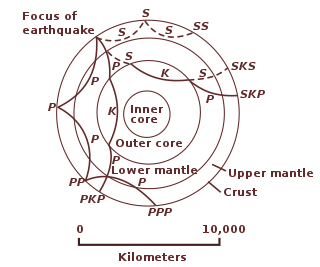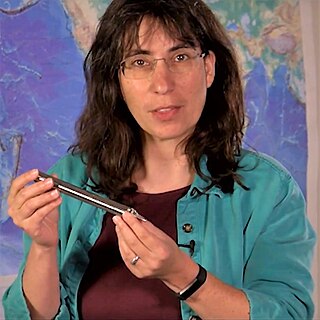Related Research Articles

Seismology is the scientific study of earthquakes and the propagation of elastic waves through the Earth or other planetary bodies. It also includes studies of earthquake environmental effects such as tsunamis as well as diverse seismic sources such as volcanic, tectonic, glacial, fluvial, oceanic, atmospheric, and artificial processes such as explosions. A related field that uses geology to infer information regarding past earthquakes is paleoseismology. A recording of Earth motion as a function of time is called a seismogram. A seismologist is a scientist who does research in seismology.

A seismic wave is a mechanical wave of acoustic energy that travels through the Earth or another planetary body. It can result from an earthquake, volcanic eruption, magma movement, a large landslide, and a large man-made explosion that produces low-frequency acoustic energy. Seismic waves are studied by seismologists, who record the waves using seismometers, hydrophones, or accelerometers. Seismic waves are distinguished from seismic noise, which is persistent low-amplitude vibration arising from a variety of natural and anthropogenic sources.

Nevado del Ruiz, also known as La Mesa de Herveo is a volcano on the border of the departments of Caldas and Tolima in Colombia, about 129 km (80 mi) west of the capital city Bogotá. It is a stratovolcano composed of many layers of lava alternating with hardened volcanic ash and other pyroclastic rocks. Volcanic activity at Nevado del Ruiz began about two million years ago, since the Early Pleistocene or Late Pliocene, with three major eruptive periods. The current volcanic cone formed during the present eruptive period, which began 150,000 years ago.
The moment magnitude scale is a measure of an earthquake's magnitude based on its seismic moment. It was defined in a 1979 paper by Thomas C. Hanks and Hiroo Kanamori. Similar to the local magnitude/Richter scale (ML ) defined by Charles Francis Richter in 1935, it uses a logarithmic scale; small earthquakes have approximately the same magnitudes on both scales. Despite the difference, news media often says "Richter scale" when referring to the moment magnitude scale.

Redoubt Volcano, or Mount Redoubt, is an active stratovolcano in the largely volcanic Aleutian Range of the U.S. state of Alaska. Located at the head of the Chigmit Mountains subrange in Lake Clark National Park and Preserve, the mountain is just west of Cook Inlet, in the Kenai Peninsula Borough about 110 miles (180 km) southwest of Anchorage. At 10,197 feet (3,108 m), in just over 5 miles (8.0 km) Mount Redoubt attains 9,150 feet (2,790 m) of prominence over its surrounding terrain. It is the highest summit in the Aleutian Range. In 1976, Redoubt Volcano was designated as a National Natural Landmark by the National Park Service.
A volcano tectonic earthquake or volcano earthquake is caused by the movement of magma beneath the surface of the Earth. The movement results in pressure changes where the rock around the magma has experienced stress. At some point, this stress can cause the rock to break or move. This seismic activity is used by scientists to monitor volcanoes. The earthquakes may also be related to dike intrusion or occur as earthquake swarms.

Galeras is an Andean stratovolcano in the Colombian department of Nariño, near the departmental capital Pasto. Its summit rises 4,276 metres (14,029 ft) above sea level. It has erupted frequently since the Spanish conquest, with its first historical eruption being recorded on December 7, 1580. A 1993 eruption killed nine people, including six scientists who had descended into the volcano's crater to sample gases and take gravity measurements in an attempt to be able to predict future eruptions. It is currently the most active volcano in Colombia.

A harmonic tremor is a sustained release of seismic and infrasonic energy typically associated with the underground movement of magma, the venting of volcanic gases from magma, or both. It is a long-duration release of seismic energy, with distinct spectral lines, that often precedes or accompanies a volcanic eruption. More generally, a volcanic tremor is a sustained signal that may or may not possess these harmonic spectral features. Being a long-duration continuous signal from a temporally extended source, a volcanic tremor contrasts distinctly with transient sources of seismic radiation, such as tremors that are typically associated with earthquakes and explosions.

The Armero tragedy occurred following the eruption of the Nevado del Ruiz stratovolcano in Tolima, Colombia, on November 13, 1985. The volcano's eruption after 69 years of dormancy caught nearby towns unaware, even though volcanological organizations had warned the government to evacuate the area after they detected volcanic activity two months earlier.

Keiiti Aki was a Japanese-American professor of Geophysics at the Massachusetts Institute of Technology (MIT), and then at the University of Southern California (USC), seismologist, author and mentor. He and Paul G. Richards coauthored "Quantitative Seismology: theory and methods".

Don Lynn Anderson was an American geophysicist who made significant contributions to the understanding of the origin, evolution, structure, and composition of Earth and other planets. An expert in numerous scientific disciplines, Anderson's work combined seismology, solid state physics, geochemistry and petrology to explain how the Earth works. Anderson was best known for his contributions to the understanding of the Earth's deep interior, and more recently, for the plate theory hypothesis that hotspots are the product of plate tectonics rather than narrow plumes emanating from the deep Earth. Anderson was Professor (Emeritus) of Geophysics in the Division of Geological and Planetary Sciences at the California Institute of Technology (Caltech). He received numerous awards from geophysical, geological and astronomical societies. In 1998 he was awarded the Crafoord Prize by the Royal Swedish Academy of Sciences along with Adam Dziewonski. Later that year, Anderson received the National Medal of Science. He held honorary doctorates from Rensselaer Polytechnic Institute and the University of Paris (Sorbonne), and served on numerous university advisory committees, including those at Harvard, Princeton, Yale, University of Chicago, Stanford, University of Paris, Purdue University, and Rice University. Anderson's wide-ranging research resulted in hundreds of published papers in the fields of planetary science, seismology, mineral physics, petrology, geochemistry, tectonics and the philosophy of science.

Prediction of volcanic activity, or volcanic eruption forecasting, is an interdisciplinary monitoring and research effort to predict the time and severity of a volcano's eruption. Of particular importance is the prediction of hazardous eruptions that could lead to catastrophic loss of life, property, and disruption of human activities.
A slow earthquake is a discontinuous, earthquake-like event that releases energy over a period of hours to months, rather than the seconds to minutes characteristic of a typical earthquake. First detected using long term strain measurements, most slow earthquakes now appear to be accompanied by fluid flow and related tremor, which can be detected and approximately located using seismometer data filtered appropriately. That is, they are quiet compared to a regular earthquake, but not "silent" as described in the past.
Episodic tremor and slip (ETS) is a seismological phenomenon observed in some subduction zones that is characterized by non-earthquake seismic rumbling, or tremor, and slow slip along the plate interface. Slow slip events are distinguished from earthquakes by their propagation speed and focus. In slow slip events, there is an apparent reversal of crustal motion, although the fault motion remains consistent with the direction of subduction. ETS events themselves are imperceptible to human beings and do not cause damage.
The historical development of geophysics has been motivated by two factors. One of these is the research curiosity of humankind related to planet Earth and its several components, its events and its problems. The second is economical usage of Earth's resources and Earth-related hazards such as earthquakes, volcanoes, tsunamis, tides, and floods.

The following outline is provided as an overview of and topical guide to geophysics:

Emily E. Brodsky is a Professor of Earth Sciences at the University of California, Santa Cruz. She studies the fundamental physical properties of earthquakes, as well as the seismology of volcanoes and landslides. In 2023, she was elected to the National Academy of Sciences.
Michel Campillo is a French seismologist and geophysicist who is currently a professor at Grenoble Alpes University.
Shamita Das is an emeritus professor at the University of Oxford and an emeritus fellow at Exeter College. She is known for her research on earthquakes, in particular the speed that earthquakes can propagate through the earth.
Marta Lucía Calvache Velasco is a Colombian geologist and volcanologist, best known for her work on geological hazards and risk reduction in Colombia.
References
- ↑ Kendall F. Haven, Donna Clark, and Donna Lynn Clark, 100 Most Popular Scientists for Young Adults: Biographical Sketches and Professional Paths (Englewood, Colorado: Libraries Unlimited, Inc., 1991), pages 91–96. Background information also provided by B. Chouet, private communication, 25 September 2008.
- ↑ Keiiti Aki, M. Fehler, and S. Das (1977) “Source mechanism of volcanic tremor: fluid-driven crack models and their application to the 1963 Kilauea eruption,” Journal of Volcanology and Geothermal Research, vol. 2, no. 3, pages 259–287.
- ↑ Bernard Chouet (1985) “Dynamics of a fluid-driven crack in three dimensions by the finite difference method,” Journal of Geophysical Research, vol. 91, no. B14, pages 13967-13992.
- ↑ F. Gil Cruz, H. J. Meyer, B. Chouet, and D. Harlow, “Observations of long-period events and tremor at Nevado del Ruiz volcano 1985–1986,” Hawaiian Symposium on How Volcanoes Work, Hilo, Hawaii, 1987.
- ↑ Bernard Chouet (28 March 1996) "Long-period volcano seismicity: its sources and use in eruption forecasting," Nature, vol. 380, no. 6572, pages 309–316.
- ↑ "Interview with Bernard Chouet about his research" . Retrieved 2012-04-28.